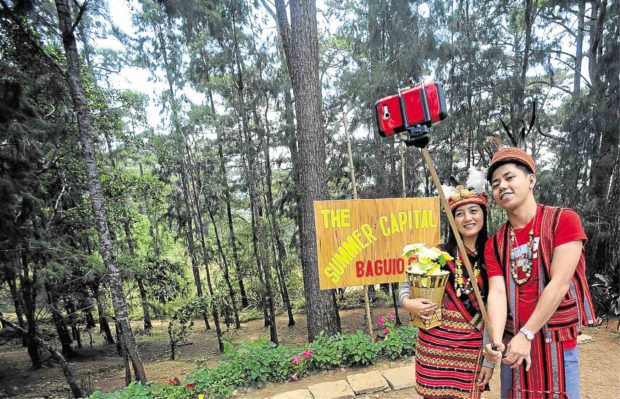Christmas chill brings tourists to Baguio

Pine trees at Baguio City’s Wright Park are ideal backdrops for visitors wanting to get that perfect shot in the summer capital. —EV ESPIRITU
BAGUIO CITY—The Christmas chill, which draws tourists to this mountain city, is here, with the temperature dropping to 12.5 degrees Celsius.
The temperature, registered at 6 a.m. on Friday, was a significant drop from the 14.2 degrees Celsius recorded on Wednesday and Thursday morning, according Eugene Ventura, weather forecaster of the Philippine Atmospheric, Geophysical and Astronomical Services Administration (Pagasa) here.
Ventura said the weather began to cool on Oct. 27, at the onset of the northeast monsoon or “amihan,” a mass of cold air blowing from Siberia.
Temperatures are expected to drop further to 12 degrees Celsius as the northeast monsoon peaks in January, he said. On Feb. 15 this year, temperature dropped to 7.3 degrees Celsius, one of the lowest recorded in almost 50 years.
The lowest temperature recorded in Baguio was on Jan. 18, 1961, when the mercury plummeted to 6.3
degrees Celsius.
The chilly weather, which lasts until late February, lures 500,000 tourists annually, according to the Department of Tourism.
Article continues after this advertisementLocal officials are bracing for traffic gridlocks at major entry points to the city, the downtown area, and roads leading to the most frequented destinations like Mines View Park, with the opening of the Pozorrubio exit at the Tarlac-Pangasinan-La Union Expressway (TPLEx) on Dec. 5.
The 88.85-kilometer expressway cuts travel time to Baguio from Quezon City to three hours and 30 minutes. TPLEx is linked to the North Luzon Expressway and the Subic-Clark-Tarlac Expressway.
According to City Hall, school playgrounds will be used for public parking as soon as students go on their Christmas break next week.
Mayor Mauricio Domogan has also asked hotels, inns and transient houses to discourage their guests from driving around the city. Instead, he said visitors should leave their cars at their hotels and commute or walk around the city.
A vehicle count conducted from September to October showed more than two million cars, buses and trucks entered Baguio, which serves as a gateway to Cordillera provinces.—KARLSTON LAPNITEN